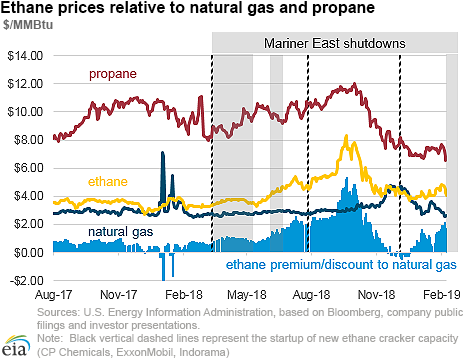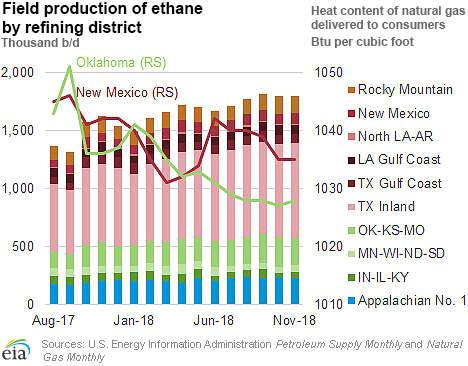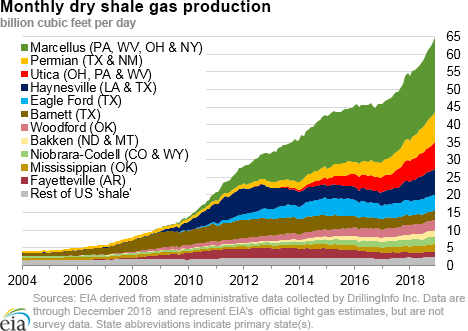In the News:
As energy markets are showing more love, ethane is feeling less rejected: ethane prices increase as market expands
After more than six years of relatively low ethane prices, recent developments in U.S. midstream and downstream ethane markets have increased ethane’s value. Ethane is no longer priced relative to natural gas on a heating-value equivalent basis; rather, ethane prices are trending closer to prices of other petroleum products and hydrocarbon gas liquids (HGL) such as propane.
Between late 2012 and mid-2017, ethane spot prices at the Mont Belvieu, Texas HGL trading hub have been range-bound, staying within $1.00 per million British thermal units (MMBtu) of the Henry Hub natural gas spot price on a heating-value equivalent basis. This pricing relationship resulted from a surplus of ethane that found its way into the natural gas stream.
Natural gas processing plants remove ethane along with other natural gas plant liquids (NGPL), but they have some discretion as to what fraction of ethane they ultimately recover. Plant operators may need to recover some ethane to produce natural gas that meets natural gas pipeline requirements, or they may choose to recover as much ethane as possible if the price of ethane exceeds the price of natural gas. Therefore, when ethane prices are linked to natural gas, processing plants often leave the ethane in the natural gas sent to interstate pipelines in a process called ethane rejection because they have no economic incentive to recover it from the natural gas stream.
Over the course of 2018, as new domestic ethylene crackers and export projects contributed to rising ethane demand and as additional fractionation and pipeline capacity entered service, ethane prices gradually increased both in real terms and relative to natural gas. Ethane is currently priced relative to other NGPL (e.g., propane, which is also used as a light feedstock). As each project entered service, ethane demand rose, leading to an increase in prices. Rising prices, in turn, have created an incentive for higher ethane recovery at natural gas processing plants because producers further afield can cover the costs of additional energy consumption and pipeline transportation.
Producing regions closer to the main center of ethane consumption in the Gulf Coast have seen the largest effects. Ethane production in the Texas Inland refining district rose 40% between August 2017 and November 2018; in New Mexico, production rose 52%; and in the Oklahoma-Kansas-Missouri refining district, production rose 67%. Dry natural gas production increased much more slowly over this time period, indicating that natural gas processors were extracting more, and consequently, rejecting less ethane.
As more ethane is recovered at natural gas plants, less ethane enters natural gas pipelines, reducing the natural gas heat content. Interstate pipelines can generally flow natural gas with a heat content of between 1,000 Btu per cubic foot (Btu/cf) and 1,100 Btu/cf. Between August 2017 and November 2018, the heat content of natural gas delivered to consumers in New Mexico fell from 1,045 Btu/cf to 1,035 Btu/cf; and in Oklahoma, the heat content of natural gas fell from 1,043 Btu/cf to 1,028 Btu/cf. Dry natural gas composed exclusively of methane has a heating value of 1,010 Btu/cf, so natural gas with a higher heat content suggests the presence of heavier gases—primarily ethane.
Nationwide, the 32% increase in ethane production corresponds to approximately 740 million cubic feet per day (MMcf/d) less natural gas delivered into the pipeline transmission system, or slightly less than 1% of the total volume of natural gas produced.
In addition to increased production of ethane, higher chemical and export demands also resulted in more robust ethane supply-demand fundamentals. For example, while previous shutdowns of the Mariner East pipeline in early- and mid-2018 resulted in material effects on ethane prices, the current Mariner East shutdown, which began on January 25, 2019, has been followed by a short-lived price increase that has since gone away, even as the pipeline remains shut.
Overview:
(For the week ending Wednesday, February 13, 2019)
- Natural gas spot price movements were mixed this report week (Wednesday, February 6 to Wednesday, February 13, 2019). Henry Hub spot prices rose from $2.56/MMBtu last Wednesday to $2.61/MMBtu yesterday.
- At the New York Mercantile Exchange (Nymex), the price of the March 2019 contract decreased 9¢, from $2.662/MMBtu last Wednesday to $2.575/MMBtu yesterday. The price of the 12-month strip averaging March 2019 through February 2020 futures contracts declined 2¢/MMBtu to $2.796/MMBtu.
- Net withdrawals from working gas totaled 78 billion cubic feet (Bcf) for the week ending February 8. Working natural gas stocks are 1,882 Bcf, which is 2% lower than the year-ago level and 15% lower than the five-year (2014–18) average for this week.
- The natural gas plant liquids composite price at Mont Belvieu, Texas, fell by 62¢/MMBtu, averaging $6.24/MMBtu for the week ending February 13. The price of ethane, propane, butane, natural gasoline, and isobutane all fell, by 9%, 9%, 7%, 3%, and 1%, respectively.
- According to Baker Hughes, for the week ending Tuesday, February 5, the natural gas rig count decreased by 3 to 195. The number of oil-directed rigs rose by 7 to 854. The total rig count increased by 4, and it now stands at 1,049.
Prices/Supply/Demand:
Prices fall across most of the country. This report week (Wednesday, February 6 to Wednesday, February 13), Henry Hub spot prices rose 5¢ from $2.56/MMBtu last Wednesday to $2.61/MMBtu yesterday. Temperatures across the Lower 48 states were warmer than normal in the east, colder than normal west of the Mississippi River, and much colder than normal across the Pacific Northwest and Great Plains. At the Chicago Citygate, prices decreased 1¢ from $2.58/MMBtu last Wednesday to $2.57/MMBtu yesterday. Prices at PG&E Citygate in Northern California fell $1.89, down from $11.23/MMBtu last Wednesday to $9.34/MMBtu yesterday. Prices at SoCal Citygate decreased $9.61 from their weekly high of $20.34/MMBtu last Wednesday to $10.73/MMBtu yesterday. Southern California prices recovered after elevated levels last week when Southern California Gas (SoCalGas) issued Low Operational Flow Orders and a notice for an electric generation curtailment.
Pacific Northwest prices volatile with record snowfall. Prices at Sumas on the Canada-Washington border fell $10.21, from $22.02/MMBtu last Wednesday to $11.81/MMBtu yesterday. Prices at Sumas surged to weekly highs of $48.69/MMBtu and $42.93/MMBtu on Friday and Monday, respectively, because of cold weather and reduced natural gas imports from Canada. Seattle, Washington, experienced record snowfall, receiving nearly a foot over the weekend. Puget Sound Energy, a Washington state utility that serves 1.1 million customers, reported that power has been restored to 339,000 customers, and fewer than 2,000 remain without power as of today.
Northeast prices rise as warmer-than-normal weather recedes. At the Algonquin Citygate, which serves Boston-area consumers, prices went up $1.06 from $2.69/MMBtu last Wednesday to $3.75/MMBtu yesterday. At the Transcontinental Pipeline Zone 6 trading point for New York City, prices increased 18¢ from $2.47/MMBtu last Wednesday to $2.65/MMBtu yesterday. The Northeast experienced unseasonably warm temperatures early in the report week, reaching daily high temperatures of 57 degrees Fahrenheit (°F) and 55 °F in Boston and New York—respectively—on Friday, February 8. However, by February 9, temperatures fell by more than 20°F, with seasonal winter temperatures persisting through the end of the report week.
Tennessee Zone 4 Marcellus spot prices increased 6¢ from $2.37/MMBtu last Wednesday to $2.43/MMBtu yesterday. Prices at Dominion South in southwest Pennsylvania rose 6¢ from $2.36/MMBtu last Wednesday to $2.42/MMBtu yesterday.
Discount at Permian Basin trading hub persists with a continued outage. A force majeure on El Paso Natural Gas’s Line 1600 that began on Wednesday, February 6 has reduced flows from 638 MMcf/d to 451 MMcf/d during the report week because of a leak. Line 1600 is located in western Texas between the Waha hub and the Texas-New Mexico state border. The notice was lifted on February 10, and the segment resumed flowing at its operating capacity, according to Genscape. Restricted flows out of the Permian Basin kept prices at the Waha Hub in West Texas down as spot prices averaged $0.51/MMBtu—their weekly low—last Wednesday, $2.05/MMBtu lower than Henry Hub prices. Yesterday, prices at the Waha Hub averaged $1.94/MMBtu, 67¢/MMBtu lower than Henry Hub prices.
TransCanada’s ANR Pipeline declares force majeure. On Monday, ANR Pipeline declared a force majeure to perform unexpected compressor repairs at its Jena Compressor Station in central Louisiana. Through February 18, the total southbound capacity will be reduced by 320 MMcf/d to 850 MMcf/d.
Supply remains flat. According to data from PointLogic Energy, the average total supply of natural gas remained the same as in the previous report week, averaging 92.6 Bcf/d. Dry natural gas production remained constant week over week.
Average net imports from Canada decreased by 4% from last week. Cold weather brought a rare and heavy snowfall to the U.S. Pacific Northwest and Western Canada. A cumulative 23 centimeters of snow fell in the population center of Vancouver from Sunday through Tuesday, increasing Canadian demand for heating and restricting imports into the United States. Imports into the Sumas border crossing point in Washington state fell from 705.7 MMcf/d on Friday to 643.3 MMcf/d during the event, according to Genscape. Freeze-offs in Canada may have also contributed to lower imports.
Demand rises. Total U.S. consumption of natural gas rose by 6% compared with the previous report week, according to data from PointLogic Energy. Natural gas consumed for power generation climbed by 11% week over week. Industrial sector consumption increased by 2% week over week. In the residential and commercial sectors, consumption increased by 4%. Natural gas exports to Mexico increased 6%.
U.S. liquefied natural gas (LNG) exports increase week over week. Six LNG vessels (five from Sabine Pass and one from Cove Point) with a combined LNG-carrying capacity of 21.3 Bcf departed the United States from February 7 to February 13, according to shipping data compiled by Bloomberg. Exports from Sabine Pass were down last week because of heavy fog restricting transit through the shipping channel, which disrupted operations at the facility. Scheduled natural gas deliveries to the terminal fell to 0.7 Bcf/d during the fog, the lowest level since January 2018, when freezing weather disrupted the water supply to the terminal. Deliveries returned to normal levels of 3.3 Bcf on Friday, according to data from Bloomberg.
Storage:
Net withdrawals from storage totaled 78 Bcf for the week ending February 8, compared with the five-year (2014–18) average net withdrawals of 160 Bcf and last year's net withdrawals of 183 Bcf during the same week. Working gas stocks totaled 1,882 Bcf, which is 333 Bcf lower than the five-year average and 30 Bcf lower than last year at this time.
According to The Desk survey of natural gas analysts, estimates of the weekly net change from working natural gas stocks ranged from net withdrawals of 63 Bcf to 106 Bcf, with a median estimate of 83 Bcf.
The average rate of net withdrawals from storage is 18% lower than the five-year average so far in the withdrawal season (November through March). If the rate of withdrawals from storage matched the five-year average of 11.3 Bcf/d for the remainder of the withdrawal season, total inventories would be 1,303 Bcf on March 31, which is 333 Bcf lower than the five-year average of 1,636 Bcf for that time of year.
More storage data and analysis can be found on the Natural Gas Storage Dashboard and the Weekly Natural Gas Storage Report.
See also:
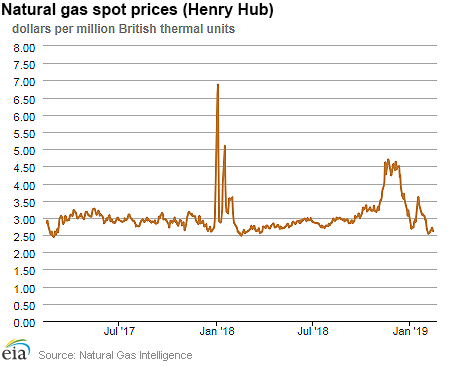
| Spot Prices ($/MMBtu) | Thu, 07-Feb |
Fri, 08-Feb |
Mon, 11-Feb |
Tue, 12-Feb |
Wed, 13-Feb |
|---|---|---|---|---|---|
| Henry Hub |
2.61 |
2.61 |
2.72 |
2.67 |
2.61 |
| New York |
2.56 |
2.70 |
2.84 |
2.71 |
2.65 |
| Chicago |
2.65 |
2.54 |
2.63 |
2.63 |
2.57 |
| Cal. Comp. Avg.* |
16.52 |
14.04 |
6.05 |
5.53 |
8.29 |
| Futures ($/MMBtu) | |||||
| March contract | 2.551 |
2.583 |
2.642 |
2.688 |
2.575 |
| April contract |
2.572 |
2.604 |
2.659 |
2.705 |
2.621 |
| *Average of NGI's reported prices for Malin, PG&E Citygate, and Southern California Border Average | |||||
| Sources: Natural Gas Intelligence and CME Group as compiled by Bloomberg, L.P. | |||||
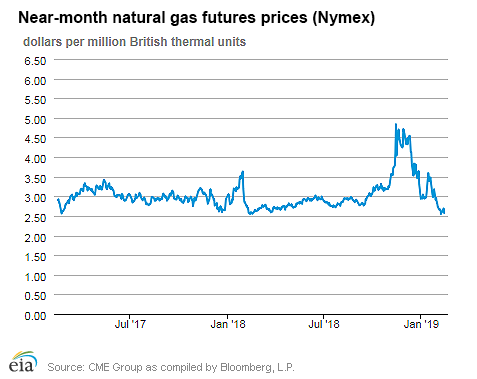
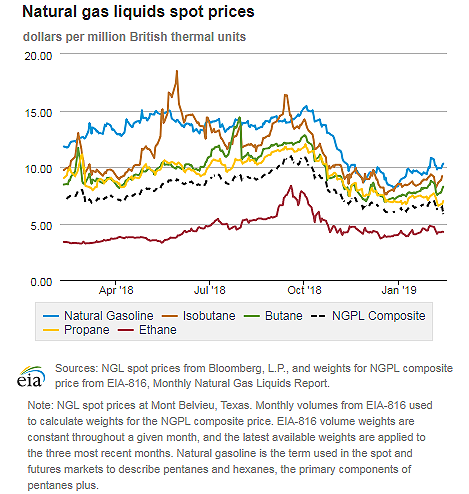
| U.S. natural gas supply - Gas Week: (2/7/19 - 2/13/19) | |||
|---|---|---|---|
Average daily values (Bcf/d): |
|||
this week |
last week |
last year |
|
| Marketed production | 98.6 |
98.3 |
88.0 |
| Dry production | 87.8 |
87.4 |
78.4 |
| Net Canada imports | 4.5 |
4.7 |
5.6 |
| LNG pipeline deliveries | 0.3 |
0.4 |
0.2 |
| Total supply | 92.6 |
92.5 |
84.3 |
|
Source: OPIS PointLogic Energy, an IHS Company | |||
| U.S. natural gas consumption - Gas Week: (2/7/19 - 2/13/19) | |||
|---|---|---|---|
Average daily values (Bcf/d): |
|||
this week |
last week |
last year |
|
| U.S. consumption | 94.8 |
89.7 |
91.1 |
| Power | 26.3 |
23.6 |
23.9 |
| Industrial | 23.6 |
23.0 |
23.6 |
| Residential/commercial | 44.9 |
43.1 |
43.7 |
| Mexico exports | 4.8 |
4.5 |
4.5 |
| Pipeline fuel use/losses | 6.9 |
6.7 |
6.4 |
| LNG pipeline receipts | 4.0 |
2.8 |
3.3 |
| Total demand | 110.5 |
103.8 |
105.2 |
|
Source: OPIS PointLogic Energy, an IHS Company | |||
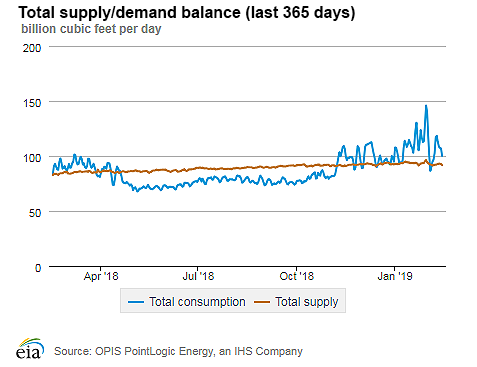
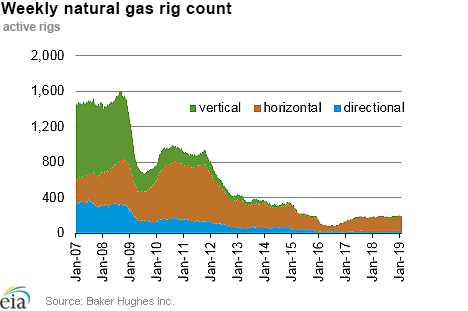
| Rigs | |||
|---|---|---|---|
Tue, February 05, 2019 |
Change from |
||
last week |
last year |
||
| Oil rigs | 854 |
0.8% |
8.0% |
| Natural gas rigs | 195 |
-1.5% |
6.0% |
| Note: Excludes any miscellaneous rigs | |||
| Rig numbers by type | |||
|---|---|---|---|
Tue, February 05, 2019 |
Change from |
||
last week |
last year |
||
| Vertical | 0 |
0.0% |
0.0% |
| Horizontal | 22 |
-12.0% |
-18.5% |
| Directional | 58 |
1.8% |
-20.5% |
| Source: Baker Hughes Inc. | |||
| Working gas in underground storage | ||||
|---|---|---|---|---|
Stocks billion cubic feet (Bcf) |
||||
| Region | 2019-02-08 |
2019-02-01 |
change |
|
| East | 444 |
468 |
-24 |
|
| Midwest | 492 |
522 |
-30 |
|
| Mountain | 95 |
105 |
-10 |
|
| Pacific | 155 |
172 |
-17 |
|
| South Central | 696 |
692 |
4 |
|
| Total | 1,882 |
1,960 |
-78 |
|
| Source: Form EIA-912, "Weekly Underground Natural Gas Storage Report" | ||||
| Working gas in underground storage | |||||
|---|---|---|---|---|---|
Historical comparisons |
|||||
Year ago (2/8/18) |
5-year average (2014-2018) |
||||
| Region | Stocks (Bcf) |
% change |
Stocks (Bcf) |
% change |
|
| East | 440 |
0.9 |
485 |
-8.5 |
|
| Midwest | 479 |
2.7 |
558 |
-11.8 |
|
| Mountain | 123 |
-22.8 |
135 |
-29.6 |
|
| Pacific | 213 |
-27.2 |
223 |
-30.5 |
|
| South Central | 657 |
5.9 |
814 |
-14.5 |
|
| Total | 1,912 |
-1.6 |
2,215 |
-15.0 |
|
| Source: Form EIA-912, "Weekly Underground Natural Gas Storage Report" | |||||
| Temperature – heating & cooling degree days (week ending Feb 07) | ||||||||
|---|---|---|---|---|---|---|---|---|
HDD deviation from: |
CDD deviation from: |
|||||||
| Region | HDD Current |
normal |
last year |
CDD Current |
normal |
last year |
||
| New England | 241 |
-31 |
-14 |
0 |
0 |
0 |
||
| Middle Atlantic | 227 |
-32 |
-36 |
0 |
0 |
0 |
||
| E N Central | 226 |
-59 |
-95 |
0 |
0 |
0 |
||
| W N Central | 283 |
-13 |
-75 |
0 |
0 |
0 |
||
| South Atlantic | 120 |
-54 |
-53 |
10 |
3 |
1 |
||
| E S Central | 79 |
-97 |
-101 |
5 |
5 |
5 |
||
| W S Central | 45 |
-79 |
-72 |
17 |
13 |
17 |
||
| Mountain | 204 |
-12 |
45 |
0 |
-1 |
-1 |
||
| Pacific | 144 |
34 |
106 |
0 |
0 |
0 |
||
| United States | 181 |
-34 |
-30 |
4 |
3 |
2 |
||
|
Note: HDD = heating degree day; CDD = cooling degree day Source: National Oceanic and Atmospheric Administration | ||||||||
Average temperature (°F)
7-day mean ending Feb 07, 2019
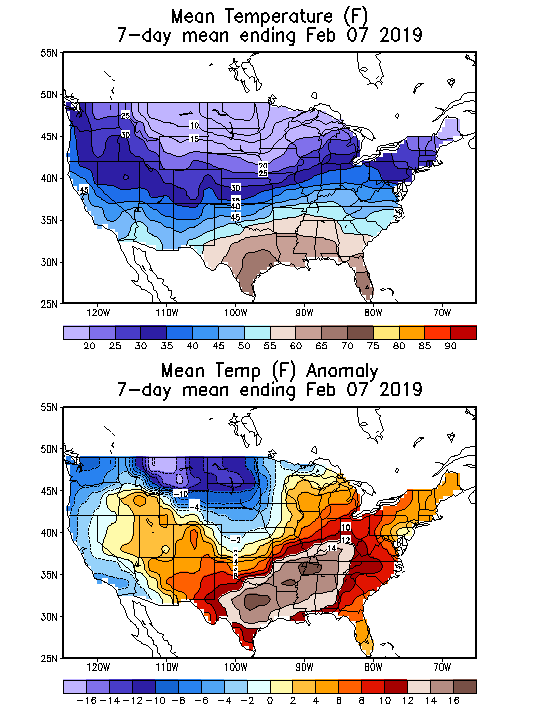
Source: National Oceanic and Atmospheric Administration
Deviation between average and normal (°F)
7-day mean ending Feb 07, 2019

Source: National Oceanic and Atmospheric Administration

